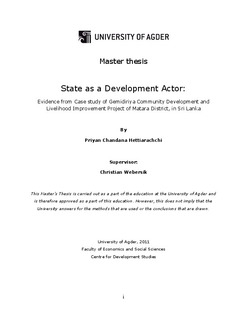| dc.description.abstract | This thesis about the state as a development actor drawing: - evidence from a case study of the Gamidiriya Community Development and Livelihood Improvement project of Matara district in Sri Lanka. The objective of this study is to identify to what extent the Gamidiriya project has been successful in improving household‟s livelihoods. Livelihood development projects are designed by the state to help to improve the quality of life for rural people by providing them with access to livelihood opportunities. The assets in the livelihood definition consists of five categories, which include social capital, financial capital, physical capital, human capital and natural capital. Hence, this study gives priority to the impact of the project on these five forms of capitals.
The research study was conducted in 15 villages from Athuraliya, Mulatiyana and Hakmana divisional secretariats in Matara district, Sri Lanka. The study employs both quantitative and qualitative research approaches to data collection and analysis. Primary and secondary data were collected by using various methods and techniques. In order to collect primary data, structured questionnaire, semi- structured interviews, observation, focus group discussions and case studies were employed. Than a sample of 150 household beneficiaries were interviewed to collect quantitative data. Fifteen semi-structured interviews were conducted in fifteen villages and six group discussions were conducted in six villages and also six case studies were done to get general information of the Gemidiriya project and people‟s perspectives of their livelihood outcomes. Secondary data is collected from analyzed text and documents. The gathered data were analyzed by using both quantitative and qualitative techniques. SPSS and case study analysis were employed for data analysis. The tables, figures, charts and texts were used for the presentation of the data.
Findings of the research confirm that, the implementation process of Gemidiriya community development and livelihood improvement project at village level is successful when considering social, financial, human and physical impact of the project for the beneficiaries. Further, findings of the research illustrate that, financial capital has improved more compared to other forms of capital of the project beneficiaries and the project has not improved the natural capital of beneficiaries. | en_US |
